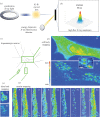Bio-metals imaging and speciation in cells using proton and synchrotron radiation X-ray microspectroscopy
- PMID: 19605403
- PMCID: PMC2843977
- DOI: 10.1098/rsif.2009.0166.focus
Bio-metals imaging and speciation in cells using proton and synchrotron radiation X-ray microspectroscopy
Abstract
The direct detection of biologically relevant metals in single cells and of their speciation is a challenging task that requires sophisticated analytical developments. The aim of this article is to present the recent achievements in the field of cellular chemical element imaging, and direct speciation analysis, using proton and synchrotron radiation X-ray micro- and nano-analysis. The recent improvements in focusing optics for MeV-accelerated particles and keV X-rays allow application to chemical element analysis in subcellular compartments. The imaging and quantification of trace elements in single cells can be obtained using particle-induced X-ray emission (PIXE). The combination of PIXE with backscattering spectrometry and scanning transmission ion microscopy provides a high accuracy in elemental quantification of cellular organelles. On the other hand, synchrotron radiation X-ray fluorescence provides chemical element imaging with less than 100 nm spatial resolution. Moreover, synchrotron radiation offers the unique capability of spatially resolved chemical speciation using micro-X-ray absorption spectroscopy. The potential of these methods in biomedical investigations will be illustrated with examples of application in the fields of cellular toxicology, and pharmacology, bio-metals and metal-based nano-particles.
Figures



References
-
- Barberet Ph., Incerti S., Andersson F., Delalee F., Serani L., Moretto Ph. 2009. Technical description of the CENBG nanobeam line. Nucl. Instr. Methods B 267, 2003–2007. (10.1016/j.nimb.2009.03.077) - DOI
Publication types
MeSH terms
Substances
LinkOut - more resources
Full Text Sources
Other Literature Sources

